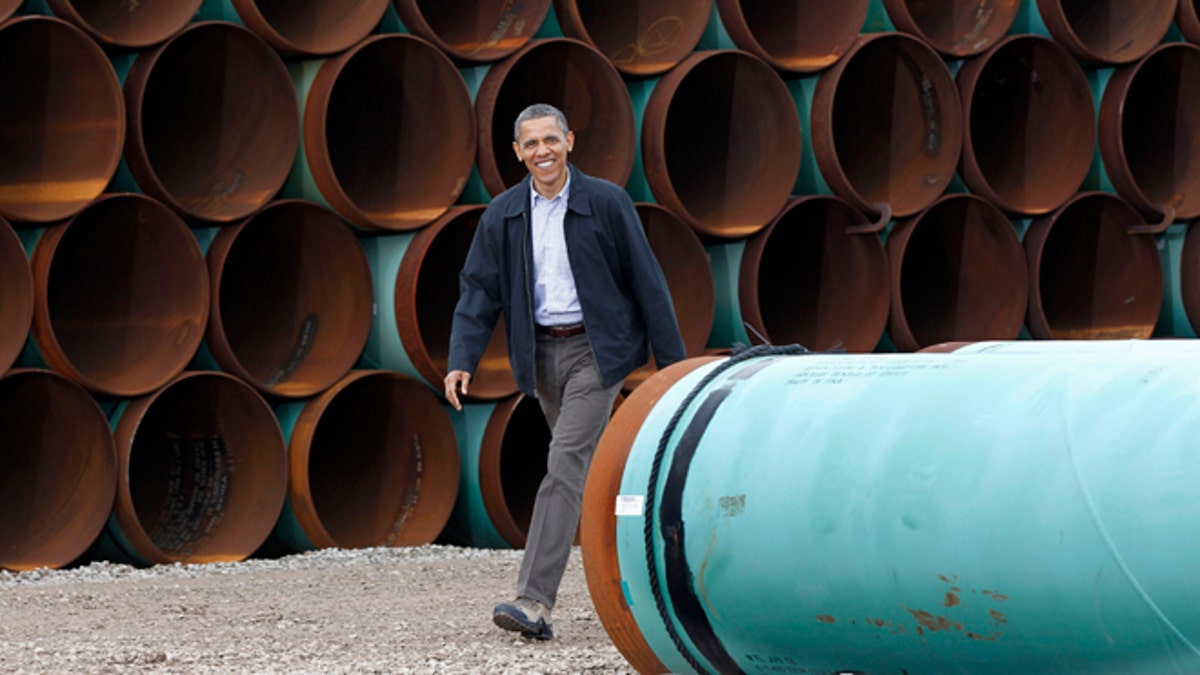
President Obama arriving at the TransCanada Stillwater Pipe Yard in Cushing, Okla. on March 22, 2012.
A rejection of the controversial Keystone XL pipeline from Canada to the United States Gulf Coast would not only make environmentalists and clean energy advocates happy, but also one of the U.S.’ feistiest opponents in the hemisphere: Venezuela.
A new report by the energy analysis company IHS Cambridge Energy Research Associates (IHS CERA) stated that Venezuelan oil would be the biggest beneficiary if the U.S. State Department rejects the Keystone XL pipeline.
“Today, the majority of heavy supply on the USGC [U.S. Gulf Coast] comes from Venezuela (0.8 mbd), followed by Mexico (0.7 mbd); the rest is from smaller suppliers including Colombia and Brazil,” Jackie Forrest and Aron Brady, analysts with HIS CERA, wrote in the report, according to the Financial Post. “If Gulf refiners cannot access Canadian heavy oil, the most likely alternative is Venezuelan supply, which is projected to grow based on ongoing investments.”
The report comes on the heels of remarks earlier this week by U.S. President Barack Obama, who downplayed the job creation benefits of the contentious $7 billion project.
During a jobs speech Tuesday in Tennessee, Obama said the pipeline's effect on jobs would be a "blip" compared with the overall economy. He also made that point in an interview with The New York Times last week.
But project supporters, including unions and lawmakers from both parties, said the president is underestimating the number of jobs it would create. Meanwhile, environmentalists urge the president to reject it, saying it would carry dirty, carbon-intensive oil.
The State Department expects to issue a final report later this year on whether the project should move forward. The department has authority over the pipeline because it crosses a U.S. border.
Besides the issue of jobs, greenhouse emissions from the proposed pipeline has weighed heavily over the decision-making process. In June, President Obama said that any emissions related to increased oil sands processing in the U.S. would weigh heavily on whether or not he ultimately approves Keystone XL.
The IHS CERA report, however, lined up with a survey by the U.S. State Department’s Draft Supplemental Environmental Impact Statement for Keystone XL, which found oil sands production is expected to continue at similar levels regardless of whether Keystone XL goes forward or not. The report also stated that Venezuela’s greenhouse gas intensity is the same as that produced by the oil sands.
“The GHG emissions from Venezuelan supply are in the same GHG intensity range as oil sands,” IHS analysts said. “Thus, in a scenario in which incremental oil sands production did not reach the U.S. Gulf market, there would be little to no change in the overall GHG intensity of the U.S. crude slate.”
The report did not look into the dangers of an oil spill if the pipeline were to rupture. Opponents of the Keystone XL worry that the pipeline could let thousands of gallons of tar sand oil spill in Canada, the Midwest or on the Gulf Coast.
In a March 2010 report, the Natural Resources Defense Council stated that "the Keystone XL Pipeline undermines the U.S. commitment to a clean energy economy," instead "delivering dirty fuel at high costs.” Later that year, 50 Democrats in Congress sent former Secretary of State Hillary Clinton a letter that warned her that "building this pipeline has the potential to undermine America's clean energy future and international leadership on climate change."
In the wake of President Obama’s comments, TransCanada –the company proposing to build the Keystone XL– said Thursday it will proceed with a $12 billion plan to pipe 1.1 million barrels of oil per day from Western Canada to the country's Atlantic coast — moving enough oil to replace all imports in Eastern Canada and still have enough left for exporting crude overseas.
The Associated Press contributed to this report.
Follow us on twitter.com/foxnewslatino
Like us at facebook.com/foxnewslatino
